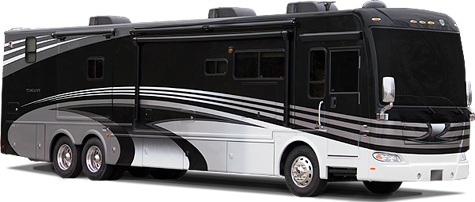Despite what people say, driving an RV is not too difficult to learn. However, just like driving a six-wheeler truck is different from driving a four-door sedan, driving an RV is definitely a unique experience. In order to ensure a safe move, follow these tips on how to drive an RV.
- Practice! Also, be sure to practice on a tight, difficult practice venue, such as narrow roads and parking lots. By learning to drive in these tight spaces, it will be easier for you once you get on the road. Whether or not you are an experienced, highly-qualified driver, be sure to practice driving an RV before setting it loose on the open road.
- Wear sunglasses to keep the sun out of your eyes. You will need to utilize your eyes to their maximum potential in order to maneuver an RV, especially during the winter.
- Be careful and alert at all times. Driving such a huge vehicle allows little room for error, so always be vigilant.
- Always keep a large distance between your RV and the car in front of you. RVs require a long braking distance, so be sure to leave a good amount of space between you and the person in front in order to avoid collisions, especially during the winter when roads are slippery.
- Take wide turns. If you drive a large truck, then you understand what this means. RVs are larger and longer than normal-sized cars, so they require wide turns to ensure a good turn without leaving the lane boundaries.
- Be vigilant in regards to blind spots. They become trickier as the vehicle gets larger, so be careful to check your blind spots consistently.
- Always be ready to hit the brakes. Since RV braking times are longer, you need to have fast reflexes and prepared reactions to ensure a clean brake.
- If you are driving in windy conditions, be prepared for the caravan to sway. The size of your RV determines the amount of shaking in the RV cabin.
- When going downhill, your RV will speed up faster than other cars due to its size. Therefore, decrease your speed when your RV hits a downhill slope.
- Slower is better than faster. If you're driving in narrow spots or in snow-covered roads, driving slow will increase your chances of safety.
- Watch out for lower sheds, bridges, branches, and other low-hanging threats when driving an RV. Since RV's are taller than other cars, these things act as obstacles/hazards.
- An RV is a fun place to interact and do activities you normally wouldn't do in a passenger car. Regardless, as a driver, make sure to keep your eyes focused on the road.
- When on the highway or freeway, you can utilize cruise control for your RV. However, do not use cruise control during the winter as this feature increases the risk of accidents.
These guidelines may seem a little overwhelming, but in reality, you would follow a good amount of these tips with a normal car to ensure a safe drive. Don't be scared or afraid to drive an RV. All you need is the right preparations and you are ready to go. Have a great move!


